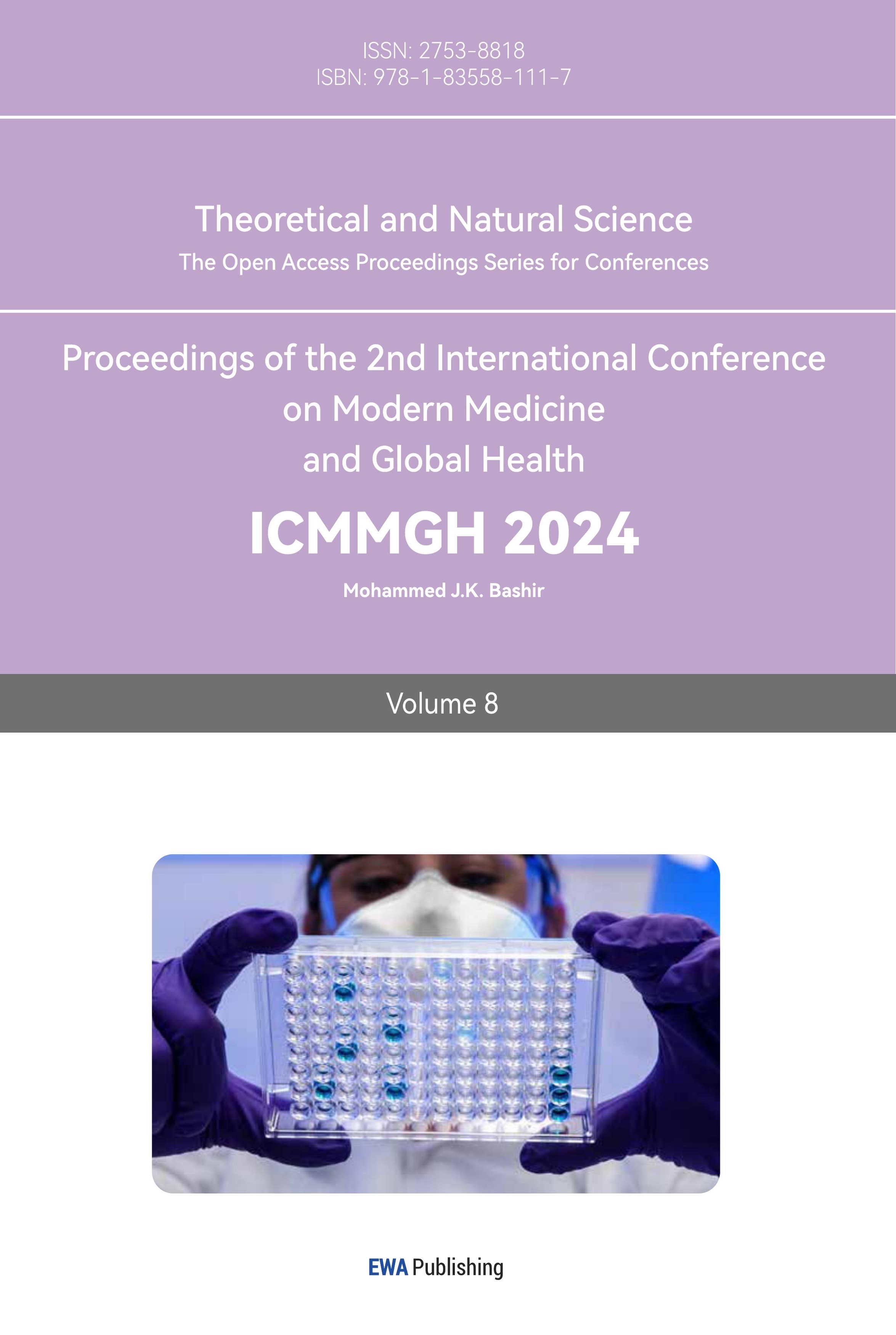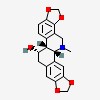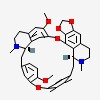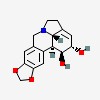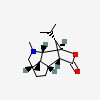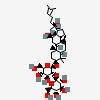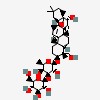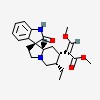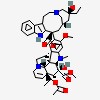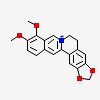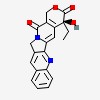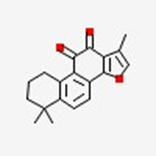1. Introduction
Non-small cell lung cancer (NSCLC) stands as a predominant form of lung malignancy, comprising approximately 85% of all diagnosed lung cancer cases. In 2020, there will be approximately 2.25 million newly diagnosed NSCLC cases worldwide. According to the 2018 China Malignant Tumor Epidemiology Report, the number of new cases of NSCLC in China was 784,000, accounting for 85.1% of all lung cancer cases. Non-small cell lung cancer (NSCLC) typically originates from the lung tissue's epithelial cells and encompasses various histological subtypes, such as adenocarcinoma, squamous cell carcinoma, large cell carcinoma, and other less common variants. These subtypes have different histologic features and pathological manifestations [1].
The pathogenesis of non-small cell lung cancer (NSCLC) is multifaceted and involves significant contributions from gene mutations. Several crucial mutations, including EGFR, ALK fusion gene, and ROS1 fusion gene, are intricately linked to the onset and progression of NSCLC. These genetic alterations play a pivotal role in shaping the disease's development and behavior [2]. Smoking constitutes a significant risk factor associated with non-small cell lung cancer (NSCLC). The act of smoking leads to DNA damage and genetic mutations, thereby elevating the susceptibility to developing NSCLC. In addition to tobacco exposure, there are genetic and environmental influences, where this includes secondhand smoke exposure, indoor air pollution, and industrial chemical exposure [3-4].
The standard approach for managing non-small cell lung cancer (NSCLC) primarily relies on early surgical intervention [5]. In the middle and late stages, immunotherapy, radiotherapy, targeted therapy and combined drug therapy are the main treatments. The main methods of TCM treatment for NSCLC include herbal therapy, acupuncture and TCM evidence-based treatment, etc. TCM treatment often adopts compound herbal formulas, which are individually formulated according to the patient's condition, physique and the principle of evidence-based treatment and exert anti-tumor effects through anti-inflammatory, regulating immune function, promoting apoptosis, inhibiting tumor angiogenesis, etc. [6, 7].
Although the current conventional method of treatment is mainly above, it is often accompanied by serious adverse reactions, so the development of highly effective and low-toxicity anti-tumor drugs has become a research hotspot. Modern research has found that the active ingredients of traditional Chinese medicine can effectively inhibit tumor growth, improve the quality of patient survival and have little toxic side effects [8]. Alkaloids are nitrogen-containing basic organic compounds extracted from natural products and are one of the most important sources of drug discovery and development, containing at least one basic nitrogen atom incorporated into its ring structure [9], which are widely found in plants of Berberidaceae, Staphylococcus, Liliaceae, and Solanaceae families etc. [10]. Alkaloids can be classified according to their structure into organic amines, pyrrolidines, pyridines, isoquinolines, indoles, scopoletanes, imidazoles, quinazolines, purines, steroids, terpenoids and others [11]. In recent years, more and more alkaloidal actives and their derivatives have been found to have favorable anti-NSCLC activity. In this paper, the research progress on the anti-NSCLC effects of alkaloidal active substances is reviewed, with a view to providing reference for drug development for the treatment of NSCLC.
2. Anti-NSCLC Effects of Alkaloidal Actives
2.1. Isoquinoline alkaloids
Chelidonine is a compound found in Chelidonium majus. In a study by Ya-Jia Xie et al., it was demonstrated that Chelidonine exhibited selective growth inhibition of gefitinib-resistant non-small cell lung cancer in EGFR mutant cells, inducing cell cycle arrest and apoptosis in H1975 cells. The mechanism of apoptosis involved mitochondrial dysfunction [12].
Cepharanthine, derived from Stephania cepharantha Hayat, has been studied for its potential in inducing apoptosis in lung cancer cells. Hua Peiyan et al. conducted research on this compound and revealed that its apoptosis-inducing effect is attributed to ROS mediation. The mechanism of action involves the up-regulation of Bax, the down-regulation of Bcl-2, and significant activation of caspase-3 and PARP, leading to apoptosis in NSCLC cells [13].
Lycorine, an isoquinoline alkaloid derived from Lycoris squamigera, has been found to possess antitumor activity. In the study conducted by Yangfang Sun et al., lycorine exhibited considerable potential in inhibiting non-small cell lung cancer cells by blocking the Wnt/β-catenin signaling pathway and impeding the epithelial-mesenchymal transition process. The results underscore the significant anticancer effects of lycorine in the context of non-small cell lung cancer [14].
2.2. Terpenoid alkaloids
Dendrobine, an active compound extracted and isolated from the stem of Dendrobium nobile Lindl, an orchid plant, has been the subject of research by Ye-Ram Kim et al. Their findings demonstrated that dendrobine effectively inhibits the migration, invasion, and metastasis of non-small cell lung cancer cells. Particularly under γ-induced conditions, dendrobine interferes with the migration and invasion of tumor cells, thus exhibiting promising potential in suppressing tumor metastasis [15].
Ginsenoside Rg3, a group of alkaloids derived from ginseng (Panax ginseng C. A. Mey.), has garnered attention in studies focusing on patients with COVID-19 non-small cell lung cancer. Zhenjie Zhuang et al. conducted research revealing that ginsenoside Rg3 exhibits beneficial effects by modulating various signaling pathways. These pathways primarily involve anti-inflammatory responses, immune regulation, cell cycle control, cell fate determination, oncology-related processes, and hemodynamics [16].
Saikosaponin D, an alkaloid extracted from the Chinese herb Bupleurum scorzonerifolium Willd, has been investigated by Shibo Wu et al. Their research revealed that Saikosaponin D exerts inhibitory effects on the activation of the STAT3 pathway. Additionally, it regulates cell proliferation and survival-related gene expression by inhibiting signaling through the STAT3 pathway. As a result, Saikosaponin D effectively suppresses the proliferation of non-small cell lung cancer cells and induces apoptosis in these cells [17].
2.3. Indole alkaloids
Corynoxine (CXN) is a compound derived from the roots and stems of the traditional Chinese medicine Uncaria macrophylla Wall. in Roxb. It belongs to the group of alkaloids found in Uncaria macrophylla. In recent studies, Corynoxine has shown remarkable effects in inhibiting cell proliferation, reducing cell viability, and inducing cytotoxicity in non-small cell lung cancer cell lines A549 and H1975. Furthermore, Corynoxine exhibited a concentration gradient-dependent ability to arrest the cell cycle at the G2/M phase in both A549 and H1975 cells. These findings suggest the potential of Corynoxine as a promising candidate for further exploration in lung cancer therapy [18].
Vinblastine and Vincristine are indole alkaloids extracted from Catharanthus roseus, which are also widely used in clinical tumor therapy. They belong to the category of microtubule inhibitors and can interfere with the mitotic process of tumor cells, thus inhibiting the growth and spread of tumor cells [19].
2.4. Quinoline alkaloids
Berberine, also known as safranin, is derived from Coptis chinensis and Phellodendron chinense. Studies have shown that berberine has antitumor activity, inhibiting the proliferation of NSCLC cells, inducing apoptosis, and inhibiting tumor invasion and metastasis. Its antitumor effects may be related to various mechanisms such as regulation of cell cycle, activation of apoptotic signaling pathways, and inhibition of inflammatory responses. The results of Alnuqaydan et al. showed that berberine-phytotriolipid liquid crystal nanoparticle formulations showed significant cytotoxic activity and antimigratory effects against NSCLC cells in in vitro experiments [20].
Camptothecine, a quinoline alkaloid derived from the Camptotheca acuminata tree, possesses potent antitumor properties. It exerts its effects by inhibiting the activity of DNA topoisomerase I through enzyme binding, which in turn induces DNA single-strand breaks. This disruption prevents DNA replication and transcription, ultimately resulting in the demise of cancer cells. Catharanthine has also undergone clinical studies as a potential candidate compound for antitumor drugs [21].
2.5. Other alkaloids
Tanshinone IIA is a phenanthrenequinone alkaloid from the roots of Salvia miltiorrhiza. Heng Zou et al. found that Tanshinone inhibited the growth and progression of non-small cell lung cancer (NSCLC) by regulating the expression of the microRNA Let-7a-5p and down-regulating the expression of AURKA (a gene associated with cell division and carcinogenesis) [22].
Sophflarine A, a piperidine alkaloid derived from the Chinese herb Sophora flavescens, exhibits a diverse range of pharmacological effects, including anti-tumor, anti-inflammatory, and antioxidant properties. Ding Luo et al. conducted research that showcased the therapeutic potential of Sophflarine A in the treatment of non-small-cell lung cancer (NSCLC). This compound exerts therapeutic effects on NSCLC cells by regulating intracellular levels of reactive oxygen species (ROS) and inducing pyroptosis and autophagy within the cells. These findings open up exciting possibilities for Sophflarine A as a potential treatment option for NSCLC [23].
The table1 is a summary of the alkaloid active substances mentioned above.
Table1. A summary of the alkaloid active substances.
material noun | source | molecular formula | functionality |
Chelidonine | Chelidonium majus |
| The Epidermal growth factor receptor-AMPK pathway exhibits selective growth inhibition on gefitinib-resistant NSCLC. It induces cell cycle arrest and apoptosis in epidermal growth factor receptor mutant cells. Additionally, it triggers apoptosis in H1975 cells through mitochondrial dysfunction [12]. |
Cepharanthine | Stephania cepharantha Hayat |
| Ceftazidime induces apoptosis in lung cancer cells through reactive oxygen species (ROS) mediation. The mechanism involves up-regulating Bax, down-regulating Bcl-2, and significantly activating caspase-3 and PARP in non-small cell lung cancer cells [13]. |
Lycorine | Lycoris squamigera |
| In non-small cell lung cancer cells, it has been shown to exhibit remarkable anticancer potential by inhibiting the epithelial-mesenchymal transition process and blocking the Wnt/β-catenin signaling pathway [14]. |
Dendrobine | Dendro bium nobile Lindl |
| Dendrobine interferes with tumor cell migration and invasion under gamma radiation-induced conditions, thereby inhibiting cancer cell metastasis [15]. |
Ginsenoside Rg3 | Panax ginseng C. A.Mey. |
| It has been observed that this intervention benefits COVID-19 non-small cell lung cancer patients through the modulation of signaling pathways. These pathways primarily involve anti-inflammation, immunomodulation, cell cycle regulation, cell fate determination, carcinogenesis, and hemodynamics [16]. |
Saikosaponin D | Bupleurum scorzonerifolium Willd. |
| By inhibiting the activation of the STAT3 pathway and signaling, this intervention effectively curtails NSCLC cell proliferation and induces apoptosis in these cells. Moreover, it exerts its effects by regulating the expression of genes associated with cell proliferation and survival in NSCLC [17]. |
Table1. (continued).
Corynoxine,CXN | Uncaria macrophylla Wall. in Roxb. |
| Significantly inhibited the proliferation, cell viability and cytotoxicity of NSCLC A549 and H1975 cells; concentration gradient-dependent induction of cell cycle arrest at G2/M phase in A549 and H1975 cells [18]. |
Vinblastine and Vincristine | Catharanthus roseus |
| It interferes with the mitotic process of tumor cells, thus inhibiting the growth and spread of tumor cells [19]. |
Berberine | Coptis chinensis, Phellodendron chinense |
| It can inhibit the proliferation of NSCLC cells, induce apoptosis, and inhibit tumor invasion and metastasis. Its anti-tumor effects may be related to multiple mechanisms such as regulation of the cell cycle, activation of apoptotic signaling pathways, and inhibition of inflammatory responses. In in vitro assays, formulations of berberine-phytotriolipid liquid crystal nanoparticles demonstrate noteworthy cytotoxic activity and antimigratory effects on non-small cell lung cancer cells [20]. |
Camptothecine | Camptotheca acuminata |
| By binding to Topoisomerase I of DNA and inhibiting its enzymatic activity, it leads to DNA single-strand breaks, thus preventing DNA replication and transcription and ultimately leading to the death of cancer cells. Camptothecin has been investigated clinically as a candidate compound for antitumor drugs [21]. |
Tanshinone IIA | Salvia miltiorrhiza |
| Suppresses the growth and progression of non-small cell lung cancer (NSCLC) by regulating the expression of microRNA Let 7a-5p and down-regulating the expression of AURKA, a gene associated with cell division and carcinogenesis [22]. |
Sophflarine A | Sophora flavescens | (not yet available) | Therapeutic effects on NSCLC by modulating intracellular ROS (reactive oxygen species) levels and inducing cells to undergo pyroptosis and autophagy [23]. |
3. The Status, Prospect and Challenge of Alkaloid Active Substance Therapy in the Comprehensive Treatment of NSCLC
The status and potential of alkaloid active substance therapy in the comprehensive treatment of non-small cell lung cancer (NSCLC) have garnered significant interest. Although modern medicine's mainstream treatments still revolve around surgical resection, radiotherapy, and chemotherapy, there is growing attention and research on the utilization of traditional Chinese medicine (TCM) as a complementary approach in NSCLC treatment. Notably, alkaloid active substances such as hippocampus alkaloids and vincristine have been explored in this context. Traditional Chinese medicine encompasses a diverse array of alkaloids with various active ingredients, including tretinoin, ophiopogonin, and chaihuanine, which have demonstrated antitumor activity. These alkaloids are involved in regulating tumorigenesis and tumor development through multiple pathways, such as inhibiting tumor cell proliferation, inducing apoptosis, blocking tumor angiogenesis, and modulating tumor-related signaling pathways. Such active substances show promise for potential benefits in treating NSCLC. As science and technology progress and research delves deeper into these alkaloids, we may gain a better understanding of their mechanisms of action in NSCLC treatment, providing a more scientific foundation for their rational application in clinical settings. The integration of traditional medicine and modern approaches may pave the way for more effective and holistic strategies in combating NSCLC.
Insufficient evidence related to clinical studies. Although some studies have shown that TCM alkaloid active substances may have certain efficacy in the treatment of non-small cell lung cancer, current studies are still relatively limited, and there is a lack of large-scale, multi-center, randomized controlled clinical trials to verify their clinical effects. Drug purity and quality control, the sources of traditional Chinese medicines are complex, the quality, purity and active ingredient content of herbs vary greatly, most alkaloids are still mainly extracted and isolated, and there may be no synthetic route for the time being, which makes it difficult to ensure the consistency and reproducibility of their therapeutic effects. And due to their natural sources and complex chemical compositions, there may be differences between different herbs or extracts, leading to instability and uncertainty of drug effects. The research on the target mechanism of action is not in-depth. Although some studies have reported the antitumor effects of alkaloid active substances in traditional Chinese medicine, their exact antitumor mechanisms have not been fully elucidated, and the lack of in-depth studies on the interaction between alkaloids and tumor cells, and the modulation of the signaling pathway has limited our comprehensive understanding of their mechanism of action and the lack of a clear target for their action. Integration of traditional medicine and modern medicine. As traditional medicines, the therapeutic concepts and modes of TCM differ from the norms and evidential requirements of modern medicine, so how to combine TCM treatment with the norms and guidelines of modern medicine and promote the integration of traditional medicine and modern medicine is an issue that needs to be addressed.
4. The Necessity and Future Direction of Developing Herbal Alkaloid Active Substance Therapy
4.1. Potential of alkaloids in the treatment of non-small cell lung cancer
Multi-pathway effect, Chinese medicine, as a traditional medicine, has a variety of active ingredients, which can regulate tumorigenesis and development through multiple pathways. Compared with single molecule-targeted drugs, Chinese medicine alkaloids can act on multiple signaling pathways and targets at the same time, which has a more comprehensive anti-tumor effect; Comprehensive treatment, non-small cell lung cancer is a complex disease, which often requires comprehensive treatment to improve the therapeutic effect. As an adjuvant treatment, TCM treatment can be combined with radiotherapy, chemotherapy and other modern medical treatments to form a comprehensive treatment advantage and improve Patient survival and quality of life; to make up for the shortcomings of the existing treatments, to discover the mother nucleus structure with good tumor inhibitory activity, structure-activity relationship, to conduct research on the mechanism of action, and to further develop such as to carry out structural modification and synthesize derivatives, and then to carry out in vitro and ex vivo evaluations and clinical studies.
4.2. Future directions
An in-depth study of the active ingredients. Through in-depth research on the active ingredients of Chinese medicine alkaloids, analyzing their anti-tumor mechanisms and action targets, so as to optimize drug design and treatment strategies. Improve drug quality control. Strengthen quality control of Chinese medicines, and ensure the consistency and stability of drugs. This includes standardizing the collection, extraction and processing of medicinal materials and establishing a drug quality evaluation and standardization system. To advance the understanding of Chinese medicine alkaloid active substances in treating non-small cell lung cancer, it is essential to bolster clinical research. This involves conducting extensive, multi-center, randomized controlled clinical trials to thoroughly evaluate their efficacy and safety. These studies will provide robust evidence on the potential benefits and risks associated with these alkaloids, contributing to the development of more effective treatment approaches for non-small cell lung cancer. At the same time, long-term follow-up and survival analysis should be strengthened to obtain more comprehensive clinical data; some comprehensive and adjuvant treatments should be carried out, combining Chinese and Western medicines, combining the individualized strategies of Chinese medicine with the advanced therapeutic drugs and guidelines of Western medicine, and combining medical treatment with the technological means of molecular biology and genetics, so as to provide excellent and effective treatment plans for patients.
5. Conclusion
Alkaloid active substances hold promise as potential candidate drugs for non-small cell lung cancer treatment, offering vast research and clinical application possibilities. To fully harness their therapeutic potential, additional in vivo and in vitro experiments, pharmacokinetic studies, and clinical trials are necessary. These efforts will provide further validation of their efficacy and aid in establishing the optimal drug administration strategy.
Through consulting the information, I also found that this road is a long way to go, we need to continue to make unremitting efforts to study. We expect to develop more effective and safer alkaloid drugs to provide better treatment options for patients with non-small cell lung cancer. It is because alkaloid actives have important research value and clinical prospects in the field of NSCLC treatment, and in the future, we will conduct further in-depth research and development which is expected to provide more effective and safe therapeutic choices for patients and bring new hope to NSCLC patients.
References
[1]. International Agency for Research on Cancer. GLOBOCAN 2020: Lung Cancer. In: Stewart BW, Wild CP, Albain KS (Editors). World Cancer Report: Cancer Research for Cancer Prevention. 16th edition. Lyon, France: International Agency for Research on Cancer; 2021.
[2]. Pao W, Girard N. New driver mutations in non-small-cell lung cancer. Lancet Oncol. 2011 Feb;12(2):175-180.
[3]. IARC. Tobacco smoke and involuntary smoking. International Agency for Research on Cancer. 2018.
[4]. Galeone, C., Pelucchi, C., & La Vecchia, C. Indoor air pollution from household use of solid fuels and risk of cancers other than lung cancer. Environmental Health Perspectives. 2008;116(4):535-540.
[5]. Howington JA, Blum MG, Chang AC. Treatment of stage I and II non-small cell lung cancer: Diagnosis and management of lung cancer, 3rd ed: American College of Chest Physicians evidence-based clinical practice guidelines. College of Chest Physicians evidence-based clinical practice guidelines. chest. 2013;143(5_suppl):e278S-e313S.
[6]. Chen H, Lu C. Traditional Chinese medicine for lung cancer. Evid Based Complement Alternat Med. 2017;2017:3705615.
[7]. Li CQ, Wang G, Li Y. Anti-tumor effects of traditional Chinese medicine targeting the cellular apoptotic pathway. Drug Discov Ther. 2019;13(6):297 -304.
[8]. Zhou Ailing, Wang Duanheng, Yue Xiaolei, et al. Progress of anti-tumor effects of Chinese medicinal polysaccharides[J]. Chinese Journal of Experimental Formulas, 2022, 28(16): 236-246.
[9]. MONDAL A, GANDHI A, FIMOGNARI C, et al. Alkaloids for cancer prevention and therapy: current progress and future perspectives[J]. Eur J Pharmacol, 2019, doi: 10. 1016/j.ejphar. 2019. 172472.
[10]. BHAMBHANI S, KONDHARE K R, GIRI A P. Diversity in chemical structures and biological properties of plant alkaloids[J]. Molecules, 2021, doi: 10. 3390/molecules26113374.
[11]. WANG Hong, LIU Yue, YANG Liangyu, et al. Progress in the study of antiviral activity of alkaloids and its mechanism[J]. Chinese herbal medicine, 2022, 53(9): 2839-2850.
[12]. Xie YJ, Gao WN, Wu QB, Yao XJ, Jiang ZB, Wang YW, Wang WJ, Li W, Hussain S, Liu L, Leung EL, Fan XX. Chelidonine selectively inhibits the growth of gefitinib-resistant non-small cell lung cancer cells through the EGFR AMPK pathway. Pharmacol Res. 2020 Sep;159:104934. doi: 10.1016/j.phrs.2020. 104934. epub 2020 May 25. pmid: 32464330.
[13]. Hua P, Sun M, Zhang G, Zhang Y, Tian X, Li X, Cui R, Zhang X. Cepharanthine induces apoptosis through reactive oxygen species and mitochondrial dysfunction in human non-small-cell lung cancer cells. Biochem Biophys Res Commun. 2015 May 1;460(2):136-42. doi: 10.1016/j.bbrc.2015.02.131. epub 2015 Mar 5. PMID: 25747710.
[14]. Sun Y, Wu P, Sun Y, Sharopov FS, Yang Q, Chen F, Wang P, Liang Z. Lycorine possesses notable anticancer potentials in on-small cell lung carcinoma cells via blocking Wnt/β-catenin signaling and epithelial-mesenchymal transition (EMT). Biochem Biophys Res Commun. 2018 Jan 1;495(1):911-921. doi: 10.1016/j.bbrc.2017.11.032. Epub 2017 Nov 7. PMID: 29127013.
[15]. Kim YR, Han AR, Kim JB, Jung CH. Dendrobine Inhibits γ-Irradiation-Induced Cancer Cell Migration, Invasion and Metastasis in Non-Small Cell Lung Cancer Cells. Biomedicines. 2021 Aug 3;9(8):954. doi: 10.3390/biomedicines9080954. PMID: 34440158; PMCID: PMC8392411.
[16]. Zhuang Z, Chen Q, Zhong X, Chen H, Yu R, Tang Y. Ginsenoside Rg3, a promising agent for NSCLC patients in the pandemic: a large-scale data mining and systemic biological analysis. J Ginseng Res. 2023 Mar;47(2):291-301. doi: 10.1016/j.jgr.2022.09.006. Epub 2022 Oct 12. PMID: 36249948; PMCID. PMC9553969.
[17]. Wu S, Chen W, Liu K, Ren F, Zheng D, Xu F, Wu H. Saikosaponin D inhibits proliferation and induces apoptosis of nonsmall cell lung cancer cells by inhibiting the STAT3 pathway. J Int Med Res. 2020 Sep;48(9):300060520937163. doi: 10.1177/0300060520937163. PMID: 32962498; PMCID: PMC7780581.
[18]. Hou GuoQing. Research on anti-tumor effect and molecular mechanism of corynoxine in human non-small cell lung cancer [D]. Science and Technology, 2020.DOI:10.27157/d.cnki.ghzku.2020.005717.
[19]. Martino E, Casamassima G, Castiglione S, Cellupica E, Pantalone S, Papagni F, Rui M, Siciliano AM, Collina S. Vinca alkaloids and analogues as anti cancer agents: looking back, peering ahead. Bioorg Med Chem Lett. 2018 Sep 15;28(17):28162826. doi: 10.1016/j.bmcl.2018.06.044. Epub 2018 Jun 25. PMID: 30122223.
[20]. Alnuqaydan AM, Almutary AG, Azam M, et al. Evaluation of the Cytotoxic Activity and Anti-Migratory Effect of Berberine-Phytantriol Liquid Crystalline Nanoparticle Formulation on Non-Small-Cell Lung Cancer In Vitro. Pharmaceutics. 2022;14(6):1119. doi: 10.3390/ Pharmaceutics14061119. pmid: 35240907.
[21]. Wall ME, Wani MC, Cook CE, Palmer KH, McPhail AT, Sim GA. Plant antitumor agents. i. The isolation and structure of camptothecin, a novel alkaloidal leukemia and tumor inhibitor from Camptotheca acuminata. J Am Chem Soc. 1966;88(16):3888-3890. pmid: 5950653.
[22]. Liu X, Zou H, Zhao Y, Chen H, Liu T, Wu Z, Yang C, Li Q, Li Y. Tanshinone Inhibits NSCLC by Downregulating AURKA Through Let-7a-5p. Front Genet. 2020 Aug 7. 11:838. doi: 10.3389/fgene.2020.00838. PMID: 32849824; PMCID: PMC7427477.
[23]. Luo D, Dai X, Tian H, Fan C, Xie H, Chen N, Wang J, Huang L, Wang H, Wang G, Zhang Y. Sophflarine A, a novel matrine-derived alkaloid from Sophora flavescens with therapeutic potential for non-small cell lung cancer through ROSmediated pyroptosis and autophagy. Phytomedicine. 2023 Jul 25;116. 154909. doi: 10.1016/j.phymed.2023.154909. Epub 2023 May 29. PMID: 37269775.
Cite this article
Hu,Y. (2023). Progress in the study of the anti-non-small cell lung cancer effects of alkaloid actives. Theoretical and Natural Science,8,7-15.
Data availability
The datasets used and/or analyzed during the current study will be available from the authors upon reasonable request.
Disclaimer/Publisher's Note
The statements, opinions and data contained in all publications are solely those of the individual author(s) and contributor(s) and not of EWA Publishing and/or the editor(s). EWA Publishing and/or the editor(s) disclaim responsibility for any injury to people or property resulting from any ideas, methods, instructions or products referred to in the content.
About volume
Volume title: Proceedings of the 2nd International Conference on Modern Medicine and Global Health
© 2024 by the author(s). Licensee EWA Publishing, Oxford, UK. This article is an open access article distributed under the terms and
conditions of the Creative Commons Attribution (CC BY) license. Authors who
publish this series agree to the following terms:
1. Authors retain copyright and grant the series right of first publication with the work simultaneously licensed under a Creative Commons
Attribution License that allows others to share the work with an acknowledgment of the work's authorship and initial publication in this
series.
2. Authors are able to enter into separate, additional contractual arrangements for the non-exclusive distribution of the series's published
version of the work (e.g., post it to an institutional repository or publish it in a book), with an acknowledgment of its initial
publication in this series.
3. Authors are permitted and encouraged to post their work online (e.g., in institutional repositories or on their website) prior to and
during the submission process, as it can lead to productive exchanges, as well as earlier and greater citation of published work (See
Open access policy for details).
References
[1]. International Agency for Research on Cancer. GLOBOCAN 2020: Lung Cancer. In: Stewart BW, Wild CP, Albain KS (Editors). World Cancer Report: Cancer Research for Cancer Prevention. 16th edition. Lyon, France: International Agency for Research on Cancer; 2021.
[2]. Pao W, Girard N. New driver mutations in non-small-cell lung cancer. Lancet Oncol. 2011 Feb;12(2):175-180.
[3]. IARC. Tobacco smoke and involuntary smoking. International Agency for Research on Cancer. 2018.
[4]. Galeone, C., Pelucchi, C., & La Vecchia, C. Indoor air pollution from household use of solid fuels and risk of cancers other than lung cancer. Environmental Health Perspectives. 2008;116(4):535-540.
[5]. Howington JA, Blum MG, Chang AC. Treatment of stage I and II non-small cell lung cancer: Diagnosis and management of lung cancer, 3rd ed: American College of Chest Physicians evidence-based clinical practice guidelines. College of Chest Physicians evidence-based clinical practice guidelines. chest. 2013;143(5_suppl):e278S-e313S.
[6]. Chen H, Lu C. Traditional Chinese medicine for lung cancer. Evid Based Complement Alternat Med. 2017;2017:3705615.
[7]. Li CQ, Wang G, Li Y. Anti-tumor effects of traditional Chinese medicine targeting the cellular apoptotic pathway. Drug Discov Ther. 2019;13(6):297 -304.
[8]. Zhou Ailing, Wang Duanheng, Yue Xiaolei, et al. Progress of anti-tumor effects of Chinese medicinal polysaccharides[J]. Chinese Journal of Experimental Formulas, 2022, 28(16): 236-246.
[9]. MONDAL A, GANDHI A, FIMOGNARI C, et al. Alkaloids for cancer prevention and therapy: current progress and future perspectives[J]. Eur J Pharmacol, 2019, doi: 10. 1016/j.ejphar. 2019. 172472.
[10]. BHAMBHANI S, KONDHARE K R, GIRI A P. Diversity in chemical structures and biological properties of plant alkaloids[J]. Molecules, 2021, doi: 10. 3390/molecules26113374.
[11]. WANG Hong, LIU Yue, YANG Liangyu, et al. Progress in the study of antiviral activity of alkaloids and its mechanism[J]. Chinese herbal medicine, 2022, 53(9): 2839-2850.
[12]. Xie YJ, Gao WN, Wu QB, Yao XJ, Jiang ZB, Wang YW, Wang WJ, Li W, Hussain S, Liu L, Leung EL, Fan XX. Chelidonine selectively inhibits the growth of gefitinib-resistant non-small cell lung cancer cells through the EGFR AMPK pathway. Pharmacol Res. 2020 Sep;159:104934. doi: 10.1016/j.phrs.2020. 104934. epub 2020 May 25. pmid: 32464330.
[13]. Hua P, Sun M, Zhang G, Zhang Y, Tian X, Li X, Cui R, Zhang X. Cepharanthine induces apoptosis through reactive oxygen species and mitochondrial dysfunction in human non-small-cell lung cancer cells. Biochem Biophys Res Commun. 2015 May 1;460(2):136-42. doi: 10.1016/j.bbrc.2015.02.131. epub 2015 Mar 5. PMID: 25747710.
[14]. Sun Y, Wu P, Sun Y, Sharopov FS, Yang Q, Chen F, Wang P, Liang Z. Lycorine possesses notable anticancer potentials in on-small cell lung carcinoma cells via blocking Wnt/β-catenin signaling and epithelial-mesenchymal transition (EMT). Biochem Biophys Res Commun. 2018 Jan 1;495(1):911-921. doi: 10.1016/j.bbrc.2017.11.032. Epub 2017 Nov 7. PMID: 29127013.
[15]. Kim YR, Han AR, Kim JB, Jung CH. Dendrobine Inhibits γ-Irradiation-Induced Cancer Cell Migration, Invasion and Metastasis in Non-Small Cell Lung Cancer Cells. Biomedicines. 2021 Aug 3;9(8):954. doi: 10.3390/biomedicines9080954. PMID: 34440158; PMCID: PMC8392411.
[16]. Zhuang Z, Chen Q, Zhong X, Chen H, Yu R, Tang Y. Ginsenoside Rg3, a promising agent for NSCLC patients in the pandemic: a large-scale data mining and systemic biological analysis. J Ginseng Res. 2023 Mar;47(2):291-301. doi: 10.1016/j.jgr.2022.09.006. Epub 2022 Oct 12. PMID: 36249948; PMCID. PMC9553969.
[17]. Wu S, Chen W, Liu K, Ren F, Zheng D, Xu F, Wu H. Saikosaponin D inhibits proliferation and induces apoptosis of nonsmall cell lung cancer cells by inhibiting the STAT3 pathway. J Int Med Res. 2020 Sep;48(9):300060520937163. doi: 10.1177/0300060520937163. PMID: 32962498; PMCID: PMC7780581.
[18]. Hou GuoQing. Research on anti-tumor effect and molecular mechanism of corynoxine in human non-small cell lung cancer [D]. Science and Technology, 2020.DOI:10.27157/d.cnki.ghzku.2020.005717.
[19]. Martino E, Casamassima G, Castiglione S, Cellupica E, Pantalone S, Papagni F, Rui M, Siciliano AM, Collina S. Vinca alkaloids and analogues as anti cancer agents: looking back, peering ahead. Bioorg Med Chem Lett. 2018 Sep 15;28(17):28162826. doi: 10.1016/j.bmcl.2018.06.044. Epub 2018 Jun 25. PMID: 30122223.
[20]. Alnuqaydan AM, Almutary AG, Azam M, et al. Evaluation of the Cytotoxic Activity and Anti-Migratory Effect of Berberine-Phytantriol Liquid Crystalline Nanoparticle Formulation on Non-Small-Cell Lung Cancer In Vitro. Pharmaceutics. 2022;14(6):1119. doi: 10.3390/ Pharmaceutics14061119. pmid: 35240907.
[21]. Wall ME, Wani MC, Cook CE, Palmer KH, McPhail AT, Sim GA. Plant antitumor agents. i. The isolation and structure of camptothecin, a novel alkaloidal leukemia and tumor inhibitor from Camptotheca acuminata. J Am Chem Soc. 1966;88(16):3888-3890. pmid: 5950653.
[22]. Liu X, Zou H, Zhao Y, Chen H, Liu T, Wu Z, Yang C, Li Q, Li Y. Tanshinone Inhibits NSCLC by Downregulating AURKA Through Let-7a-5p. Front Genet. 2020 Aug 7. 11:838. doi: 10.3389/fgene.2020.00838. PMID: 32849824; PMCID: PMC7427477.
[23]. Luo D, Dai X, Tian H, Fan C, Xie H, Chen N, Wang J, Huang L, Wang H, Wang G, Zhang Y. Sophflarine A, a novel matrine-derived alkaloid from Sophora flavescens with therapeutic potential for non-small cell lung cancer through ROSmediated pyroptosis and autophagy. Phytomedicine. 2023 Jul 25;116. 154909. doi: 10.1016/j.phymed.2023.154909. Epub 2023 May 29. PMID: 37269775.





